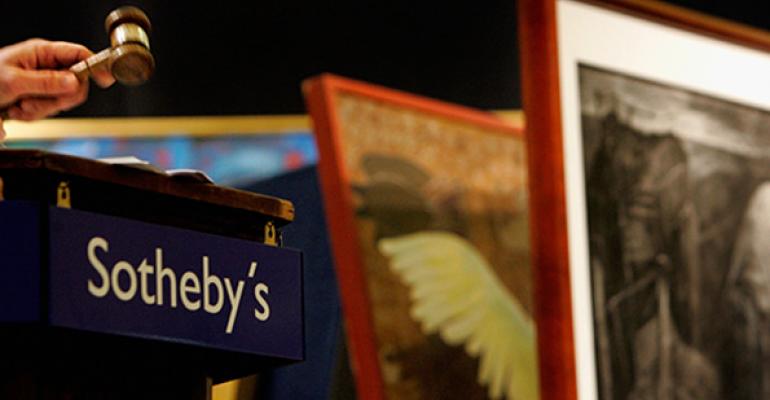On Monday, June 17, 2019, to the art world's great surprise, after 31 years as a public company, Sotheby's announced that it had signed a $3.7 billion merger agreement with BidFair USA, an entity wholly owned by billionaire art collector Patrick Drahi. To shareholders' presumed delight, the deal will see shareholders receiving $57.00 in cash per share of Sotheby's common stock, which represents a premium of 61% to the stock's closing price on June 14, 2019, and a 56.3% premium to the company's 30 trading-day volume weighted average share price.
Who is Patrick Drahi and why would he pay a premium to acquire Sotheby's?
Drahi, 55, is a French/Israeli/Portuguese media and telecom entrepreneur and a collector of Impressionist and Modern art. He has amassed his $9.2 billion fortune through his ventures in the telecommunications industry, and is the controlling shareholder of Altice Europe NV, the publicly-traded Netherland-based company he founded to acquire dozens of cable and mobile operators in France, and more recently, the US. Until now, unlike other billionaire art collectors, including Christie's' French owner François-Henri Pinault, Drahi was not a household name among many in the art market. So what led him to make this purchase? Several in the art world have claimed that this move represents a trophy acquisition rather than a pure financial investment. Drahi himself has provided some limited insight into his motivations in his statement from last Monday: "I am honored that the Board of Sotheby's has decided to recommend my offer.... For my entire life, I have been passionate about this industry and I believe the opportunities and growth potential are significant for Sotheby’s….Sotheby's is one of the most elegant and aspirational brands in the world. As a longtime client and lifetime admirer of the company, I am acquiring Sotheby's together with my family."
Effect of the Acquisition
The acquisition will return the 275-year-old auction house to private hands, after a 31-year stretch as a public company. Returning Sotheby's to a position alongside its primary art auction rivals, Christie's, Phillips, and Bonhams, which have long been privately held. Through its quarterly public filings, Sotheby's was an outlier in a market seen by many to be opaque and shrouded in secrecy. Sotheby's was required to report its earnings and losses on a quarterly basis, giving the public regular insight into the realities of the blockbuster fall and spring auctions' financial success or failure, the company's strategy, and the art market's overall health. Although useful for sellers, buyers, dealers and shareholders, these disclosure requirements were often seen to be a competitive disadvantage for Sotheby's, compared with its auction house rivals which, as private companies, were not required to make such disclosures. In fact, Sotheby's CEO, Tad Smith, touted this point in his statement about the acquisition last week: "This acquisition will provide Sotheby's with the opportunity to accelerate the successful program of growth initiatives of the past several years in a more flexible private environment. It positions us very well for our future, and I strongly believe that the company will be in excellent hands for decades to come with Patrick as our owner." Based on Smith's own view, "a more flexible private environment" will be beneficial for the company going forward.
Looking to the future, Sotheby's going private could usher in many changes. However, for executors looking to sell estate assets, the area where we foresee the most potential for change is in the shifting landscape of third-party-backed irrevocable bid guarantees. Irrevocable bid guarantees initially became popular in the auction business as a way to attract sellers, which were often estates needing a set amount of guaranteed sale proceeds to pay estate taxes, by providing a "guarantee" in the form of a set payment, regardless of whether the seller's art ultimately sold at auction. These guarantees have proven particularly useful for executors who do not want to worry about disposing of assets, which failed to sell at auction, that could delay the process of closing an estate. These guarantees were often discussed at the beginning of consignment negotiations and requested by the sellers themselves to secure funds. To lock in such guarantees, the auction houses would then seek out collectors already interested in the art being offered to serve as the third party guarantors securing the financing transactions. The collectors would receive, in exchange for the guarantee, a percentage of the house's commission on the sale. In recent years, however, there has been a shift in the guarantee arena with a number of buy-side investment players coming to auction houses offering to secure guarantees after reviewing what art is being offered in the published catalogues. This has shifted the timing of the negotiation of guarantees. Now, instead of guarantee requests being exclusively made by sellers at the beginning of a consignment negotiation, increasingly, guarantees are being offered to sellers by the auction houses, on behalf of investors wanting to offer financing, sometimes as late as the day of a sale.
Freed from the burden of the public disclosure requirements, which meant disclosure to its competitors, we are curious to see whether Sotheby's will be eager to embrace new creative strategies being presented by estates as well as by investment and tech companies in the guarantee arena – a move that may result in more varied business options for auction sales.





